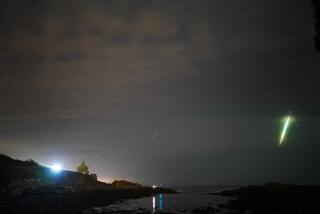Leonid meteor shower peaks this weekend: Watch with NASA online
- Share via
Stargazers, get psyched: The Leonid meteor shower is expected to peak late Friday night and continue through the weekend.
If you can find a clear, dark spot where the starry night sky is visible, you can expect to see as many as 15 to 20 shooting stars per hour.
The Leonid meteor shower takes place each November as the Earth passes through a ring of rocky debris left by the comet Tempel-Tuttle.
The number of shooting stars we get to see down here is determined by what part of the comet’s orbit we pass through on any given year. In 1996, a pass through a really rocky part of the comet’s orbit led to a meteor storm of up to 1,000 per hour.
The 15 to 20 meteors per hour expected this year is considered average for the Leonids.
If you live in a city like Los Angeles, where light pollution makes it difficult to see any stars at all, you’ve got a few options for catching this annual meteor shower.
You could head out to the desert or up into the mountains to get away from the city lights.
However, here in the West, cloudy skies may make the Leonids difficult to view.
Your best bet may be to watch the shower online with thousands of other virtual stargazers. NASA’s Marshall Space Flight Center has set up a live Ustream feed of the view from a telescope turned to the skies over Huntsville, Ala. It will be running through Tuesday.
Watching a celestial event on a computer screen doesn’t have the same magic as lying on your back in the dark of night and watching directly, but it does let you participate in a global stargazing experience without leaving the comfort of your own light-polluted town.
ALSO:
Spacing out with Google’s map of 100,000 stars
Total solar eclipse last Tuesday, streamed live online
Google reportedly putting finishing touches on Maps app for iOS 6
More to Read
Inside the business of entertainment
The Wide Shot brings you news, analysis and insights on everything from streaming wars to production — and what it all means for the future.
You may occasionally receive promotional content from the Los Angeles Times.











